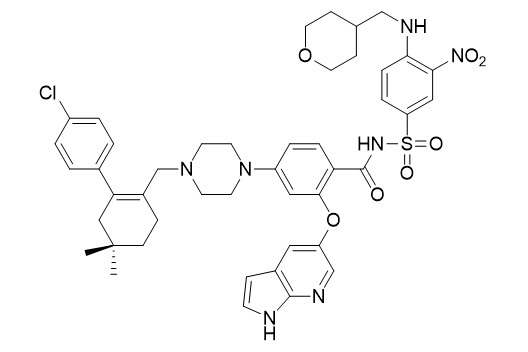Venetoclax (ABT-199)
Venetoclax (ABT-199, GDC-0199) is a Bcl-2-selective inhibitor with Ki of <0.01 nM in cell-free assays, >4800-fold more selective versus Bcl-xL and Bcl-w, and no activity to Mcl-1. Venetoclax is reported to induce cell growth suppression, apoptosis, cell cycle arrest, and autophagy in triple negative breast cancer MDA-MB-231 cells.
Inquire / Order:
manager@chemfaces.com
Technical Inquiries:
service@chemfaces.com
Tel:
+86-27-84237783
Fax:
+86-27-84254680
Address:
1 Building, No. 83, CheCheng Rd., Wuhan Economic and Technological Development Zone, Wuhan, Hubei 430056, PRC
Providing storage is as stated on the product vial and the vial is kept tightly sealed, the product can be stored for up to
24 months(2-8C).
Wherever possible, you should prepare and use solutions on the same day. However, if you need to make up stock solutions in advance, we recommend that you store the solution as aliquots in tightly sealed vials at -20C. Generally, these will be useable for up to two weeks. Before use, and prior to opening the vial we recommend that you allow your product to equilibrate to room temperature for at least 1 hour.
Need more advice on solubility, usage and handling? Please email to: service@chemfaces.com
The packaging of the product may have turned upside down during transportation, resulting in the natural compounds adhering to the neck or cap of the vial. take the vial out of its packaging and gently shake to let the compounds fall to the bottom of the vial. for liquid products, centrifuge at 200-500 RPM to gather the liquid at the bottom of the vial. try to avoid loss or contamination during handling.
Onco Targets Ther.2017, 10:3467-3474
Biomed Pharmacother.2024, 175:116770.
Natural Product Communications2020, doi: 10.1177.
Molecules.2019, 24(23):E4303
Microbiol. Biotechnol. Lett.2022, 50(2): 193-201.
European Journal of Integrative Medicine2018, 20:165-172
Chemistry of Natural Compounds2018, 204-206
Anticancer Res.2024, 44(3):1033-1044.
J Ethnopharmacol.2023, 309:116302.
Food Chem.2018, 252:207-214
Related and Featured Products
Nat Med,2013 Feb;19(2):202-8.
ABT-199, a potent and selective BCL-2 inhibitor, achieves antitumor activity while sparing platelets.[Pubmed:
23291630]
Binding affinities (Ki or IC50) of ABT-199 against different isoforms of Bcl-2 family are determined with competitive fluorescence polarization assays. The following peptide probe/protein pairs are used: f-bad (1 nM) and Bcl-xL (6 nM), f-Bax (1 nM) and Bcl-2 (10 nM), f-Bax (1 nM) and Bcl-w (40 nM), f-Noxa (2 nM) and Mcl-1 (40 nM), and f-Bax (1 nM) and Bcl-2-A1 (15 nM). Binding affinities for Bcl-xL are also determined using a time-resolved fluorescence resonance energy transfer assay. Bcl-xL (1 nM, His tagged) is mixed with 200 nM f-Bak, 1 nM Tb-labeled anti-His antibody, and ABT-199 at room temperature for 30 min. Fluorescence is measured on an Envision plate reader using a 340/35 nm excitation filter and 520/525 (f-Bak) and 495/510 nm (Tb-labeled anti-His antibody) emission filters.
Nat Med, 2013, 19(2), 202-208.
ABT-199, a potent and selective BCL-2 inhibitor, achieves antitumor activity while sparing platelets.[Pubmed:
23291630]
Cell lines:NHL, DLBCL, MCL, AML and ALL cell lines
Concentrations: ~1 μM
Incubation Time: -48 hours
Method:
RS4;11 cells are seeded at 5 × 104 per well in 96-well plates and treated with ABT-199 diluted in half-log steps starting at 1 μM-0.05 nM. Leukemia and lymphoma cell lines are seeded at 1.5-2 × 104 cells per well in the appropriate medium and incubated with ABT-199 for 48 h. Effects on proliferation are determined using Cell TiterGlo reagent. EC50 values are determined by nonlinear regression analysis of the concentration-response data.



